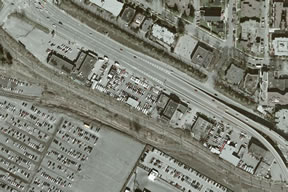For over a month Musqueam community members and their supporters have been maintaining a 24-hour vigil at the ancient village of c̓əsnaʔəm (also known as the Marpole Midden), the site of a planned 108-unit residential condo development. The action started On May 3, 2012 when a group of over 100 protestors marched to c̓əsnaʔəm to demonstrate commitment to the appropriate and respectful care of their ancestors and to demand action.
c̓əsnaʔəm, located by the north end of the Arthur Laing bridge between Vancouver and the airport, was designated a National Historic Site of Canada in 1933. It is recognized in the Canadian Register of Historic Places (CRHP) as an important archeological site and one of the largest pre-contact middens on the Pacific coast of Canada.
Musqueam has proposed a land swap and the creation of a public heritage park that would preserve the site, a plan that has been supported by the City of Vancouver but which also requires the involvement of the BC Government.
The historical and cultural significance of the site and the continued relationship Musqueam have with c̓əsnaʔəm are explored in former UBC instructor and PhD student Susan Roy’s 2010 book These Mysterious People: Shaping History and Archaeology in a Northwest Coast Community.
Dr. Roy, a former UBC First Nations Studies Program instructor, completed her PhD In Interdisciplinary Studies at UBC in 2007. Her thesis Who Were These Mysterious People?: the Marpole Midden, Coast Salish Identity, and the Dispossession of Aboriginal Lands in British Columbia, served as the basis for her subsequent book. Roy asks, “What happens to the land that does not become an Indian reserve but is clearly marked with Indianness?”
Roy also notes ongoing discussions among Musqueam regarding cultural objects and ancestral remains lost to the community through a long succession of colonial practices that have separated Aboriginal peoples from their traditional territories and sacred and ancestral sites—a process that the commercial development of c̓əsnaʔəm would continue.
The stories of village and burial sites such as c̓əsnaʔəm offer good examples of the “often divergent Aboriginal and Western concepts of what constitutes material evidence about the past, human occupation and place.” Roy argues that by considering the history of these places “we can gain a better understanding of the evolving relationships between Aboriginal and non-Aboriginal communities.”
Musqueam’s peaceful protest at c̓əsnaʔəm reflects Roy’s assertion that in spite of colonization and the imposed separation from their traditional territories, Aboriginal people continue to work towards reclamation, revitalization, and reassertion of their inherent rights.
Roy’s book is a great source for more information on the broader issues surrounding c̓əsnaʔəm. For more information on the book see the McGill Press site. The book is also available on campus at the bookstore and the Xwi7xwa Library.
For more information on c̓əsnaʔəm visit the Musqueam website.
